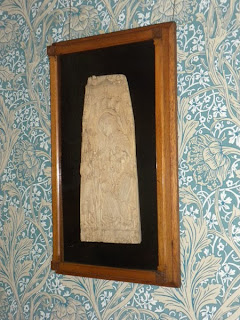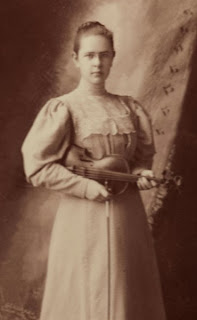Today marks the 50th anniversary of
the assassination of President John F. Kennedy in Dallas, Texas. The event has become a part of popular
culture, and virtually all those old enough to remember the tragedy can recall
where they were when they received the news that the president was dead.
It is interesting to note that John and Frances
Glessner lived through the assassination of three U.S. presidents – Lincoln in
1865, Garfield in 1881, and McKinley in 1901.
In this article, the first of three to explore those events, we will
explore the Glessners’ interest in Lincoln.
In 1865, John Glessner was 22 and his future
wife Frances Macbeth was just 17. Frances
Glessner would not start recording events in her journal until 1870, the year
she married. As such, the only record of
Lincoln’s assassination in the museum archives exists in two letters to John
Glessner from his sister, Mary (Glessner) Kimball, and one to Frances from her
mother Nancy Macbeth.
The first letter to John Glessner is dated Sunday
April 16, 1865, the day after Lincoln died.
After a lengthy discussion of selling her home in Canton, Ohio and
preparing to move, Mary notes:
“Wasn’t
the killing of Lincoln a dreadful affair?
Our church was draped in black for him today and Mr. Buckingham preached
on that subject. His text was ‘A prince
and a great man has fallen in Israel.’
His sermon was very good. He said
he hoped the mantle of Lincoln would fall upon Johnson but he trembled lest it
would not.”
The second letter, written one week later on
April 23, makes brief mention of Lincoln’s funeral train:
“If I get
an answer to a letter I wrote to cousin Laura and she invites me to go to Mrs.
Child’s to spend a day or two, I will go; I would be there then the day Lincoln’s
remains are.”
The reference is to Lincoln’s funeral train
which entered Ohio early on Friday April 28th, making a
stop in Cleveland that morning, and a longer stop in Columbus the next day,
where it remained for eleven hours. The
train left Ohio early in the morning on Sunday April 30th.
The letter to Frances (called Fannie by her
family) from her mother is a bit more detailed in describing the reaction
people had to learning of Lincoln’s death.
In a letter from Springfield, Ohio dated Sunday April 16, 1865, she
wrote:
“Dear Fannie: I know
you are thinking of me this day and wondering how I felt under the terrible
news of the death of our beloved President – and I am sure I cannot tell you –
it would be hard to convey to your mind the sadness and sorrow that we all feel
at this time – the loyal American nation is in mourning for this sad
bereavement. Our church was all draped
in mourning, all the flags and everybody almost had on some token of the
sadness they felt within. Mr. Bower preached
a regular funeral discourse and a very good one, too – Friday was a great day
of rejoicing here as well as everywhere else, but alas how quickly our joy was
turned into sadness.”
The rejoicing on Friday is a reference to learning
the news of the end of the Civil War.
THE LINCOLN LIFE MASK
One
of the most important objects visitors to the museum see during their tour is
the bronze life mask and hands of Abraham Lincoln that is displayed on the partner’s
desk in the library. This is the story
of how those relics came to be.
Chicago
sculptor Leonard W. Volk first met Lincoln in 1858 during Lincoln’s historic
debates with Stephen Douglas. During
that meeting, Lincoln promised to sit for the sculptor. In April 1860, Volk saw a newspaper article
announcing Lincoln’s arrival in Chicago to argue a case. Volk went to the courthouse and reminded
Lincoln of his old promise. Lincoln
readily agreed to begin sitting, paying a visit to Volk’s studio each morning
for a week. If he could take a mask of
Lincoln’s face, Volk explained, the number of sittings could be greatly
reduced. At the session where the mask
was made, Lincoln sat in a chair and carefully watched every move Volk made by
way of a mirror on the opposite wall.
The plaster was carefully applied without interfering with Lincoln’s
eyesight or breathing through the nostrils.
After an hour, the mold was ready to be removed. Lincoln bent his head low and gradually
worked it off without breaking or injury, although in the process he did pull a
few hairs from his temples, causing his eyes to water. Lincoln continued to sit for Volk for five
days after the mask was prepared, Lincoln entertaining Volk with “some of the
funniest and most laughable of stories.”
The
next month, Volk was on the train to Springfield when he heard the news of
Lincoln’s nomination by the Republicans.
He arrived in Springfield and rushed to Lincoln’s house, announcing to
the astonished candidate, “I am the first man from Chicago, I believe, who has
the honor of congratulating you on your nomination for President.” Volk insisted that he now must execute a
full-length statue of Lincoln, and Lincoln agreed to provide Volk with
appropriate photographs of himself, while Volk would take his measurements as
well as make casts of his hands. Volk
appeared at the Lincoln’s home on the next Sunday morning and set to work in
the dining room. He suggested that
Lincoln should be holding something in his right hand for the cast. Lincoln disappeared to the woodshed and
returned whittling off the end of a piece of broom handle. When Volk said that was not necessary,
Lincoln remarked cheerfully, “I thought I would like to have it nice.” Volk noticed that the right hand was still
severely swollen from the handshaking of Lincoln’s latest campaign – a
difference that is visible in the casts.
Volk commented on a scar on Lincoln’s left thumb, and Lincoln explained
that it was a souvenir of his days as a rail-splitter. “One day, while I was sharpening a wedge on a
log, the ax glanced and nearly took my thumb off.” After the casts were completed, Volk set off
for Chicago with the molds, photographs, a black suit left over from Lincoln’s
1858 campaign, and a pair of Lincoln’s pegged boots.
Volk
never completed the statue, and later gave the casts of Lincoln’s face and hands
to his son Douglas, himself an artist, who later passed them on to a fellow art
student, Wyatt Eaton. During the winter
of 1885-1886, Richard Watson Gilder saw the casts in Eaton’s studio and
immediately grasped their significance.
On
February 1, 1886,
Gilder, along with his friends Augustus St. Gaudens and Thomas B. Clarke, sent
out a letter to a select group of individuals which read in part:
“The undersigned have
undertaken to obtain the subscription of fifty dollars each, from not less than
twenty persons, for the purchase from Mr. Douglas Volk of the original casts
taken by his father, the sculptor, Mr. Leonard W. Volk, from the living face
and hands of Abraham Lincoln, to be presented, together with bronze replicas
thereof, to the Government of the United States for preservation in the
National Museum at Washington.
“The subscribers are
themselves each to be furnished with replicas of the three casts, in plaster or
bronze. If in plaster, there will be no
extra charge beyond the regular subscription of $50; if the complete set is
desired in bronze, the subscription will be for $85 . . .
“Those wishing to take
part in the subscriptions will notify at once either of the undersigned.”
Subscriptions
were apparently received rapidly.
Frances Glessner recorded the following entry in her journal on May 30, 1886:
Last week we got a
bronze cast of Lincoln’s life mask and hands made by Douglas (sic) Volk – a few
copies have been made to raise funds enough to give the originals to the
government.”
The
underside of the life mask contains the following inscription:
“THIS CAST WAS MADE FOR
J. J. GLESSNER A SUBSCRIBER TO THE FUND FOR THE PURCHASE AND PRESENTATION TO THE UNITED STATES GOVERNMENT OF
THE ORIGINAL MASK MADE IN CHICAGO APRIL 1860 BY LEONARD W. VOLK FROM THE LIVING
FACE OF ABRAHAM LINCOLN. THIS CAST WAS
TAKEN FROM THE FIRST REPLICA OF THE ORIGINAL IN NEW YORK
CITY FEBRUARY 1886. COPYRIGHT 1886 BY LEONARD W. VOLK.”
The
stump end of each hand contains the following inscription:
“COPYRIGHT 1886 BY LEONARD
W. VOLK. THIS CAST OF THE HAND OF ABRAHAM LINCOLN WAS MADE FROM THE FIRST
REPLICA OF THE ORIGINAL MADE AT SPRINGFIELD ILL THE SUNDAY FOLLOWING HIS
NOMINATION TO THE PRESIDENCY.”
Volk's plaster life mask and hands on display at the National Portrait Gallery in Washington D.C. beside the second life mask created by Clark Mills in February 1865.
In
1888, the original plaster mask and hands, together with the first bronze
casts, were presented to the National Museum (now the Smithsonian Institution)
along with an elaborate illuminated manuscript which read in part:
“This case contains the
first cast made in the mold taken from the living face of ABRAHAM LINCOLN by
Leonard W. Volk sculptor in Chicago in the year 1860. Also the first casts made in the molds from
Lincoln’s hands likewise made by Leonard W. Volk in Springfield Illinois, on
the Sunday following Lincoln’s nomination for the Presidency in May 1860. Also the first bronze casts of the facemold,
and bronze casts of the hands. Presented
to the Government of the United States for deposit in the National Museum by
Thirty Three Subscribers.”
The
list of subscribers includes the name of J. J. Glessner, as well as J. Q. A.
Ward, Frances Glessner’s first cousin, a talented sculptor who created the
bronze standing Shakespeare on display in the library. Ward and St. Gaudens were close friends, and
it is possible that Ward suggested that St. Gaudens include John Glessner on
the mailing list, when the original subscription letter was mailed in February
1886.
BEYOND THE MASK
John
Glessner was a Sustaining Member of the Lincoln Centennial Association,
organized in 1909, and renamed The Abraham Lincoln Association in 1929. His library contained over three dozen books
and booklets on Lincoln, which he kept on a shelf in the southeast bookcase in
the library. The books include such
standards as Carl Sandburg’s two volume Abraham
Lincoln: The Prairie Years, as well as more obscure titles, many of which
were issued by the Association. An
interesting volume, of which only 750 copies were printed, is Abraham Lincoln in New Hampshire, which
recounts Lincoln’s visit to that state in 1860.
The author, Elwin L. Page, was a friend of George and Alice Glessner,
and Alice presented the volume to her father-in-law upon its publication in
1929.

John
Glessner also owned a photograph of Lincoln.
The cabinet card, featuring an image taken at Eaton’s Studios, carried
the following inscription: “For Mrs.
Lucy G. Speed, from whose pious hand I accepted the present of an Oxford Bible
twenty years ago. Washington, D.C., October 3, 1861. A. Lincoln.”
Lucy G. Speed was the mother of Lincoln’s closest friend, Joshua F.
Speed, and had presented the Bible to Lincoln during his visit to the Speed
home in August 1841, in the hopes of relieving his depression and
melancholia. The original photograph
remained in the Speed family until the 1990s, but copies were apparently made,
one of which was purchased by John Glessner.
The photograph was donated to the Chicago Historical Society in April
1940 by Frances Glessner Lee.











































